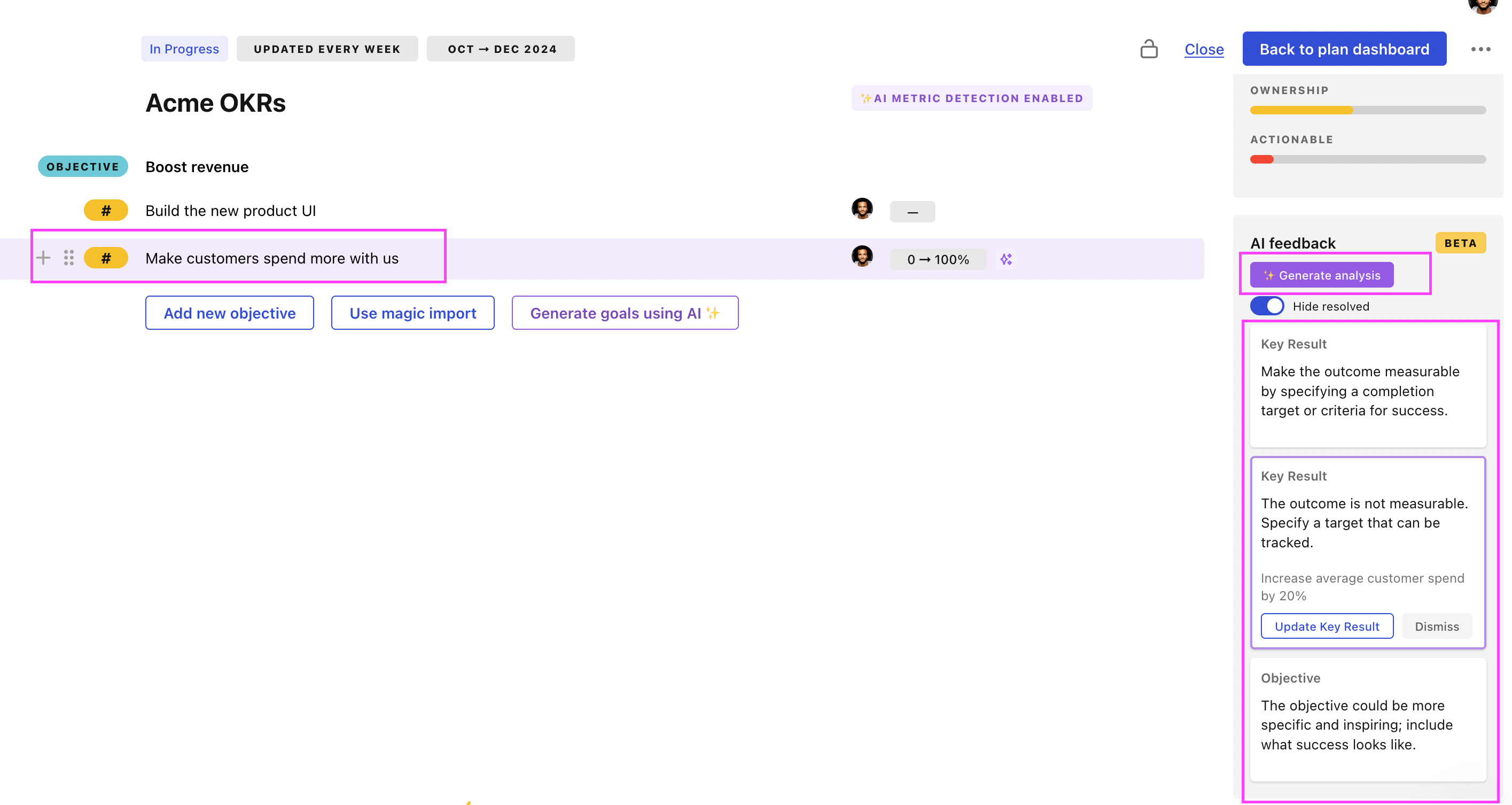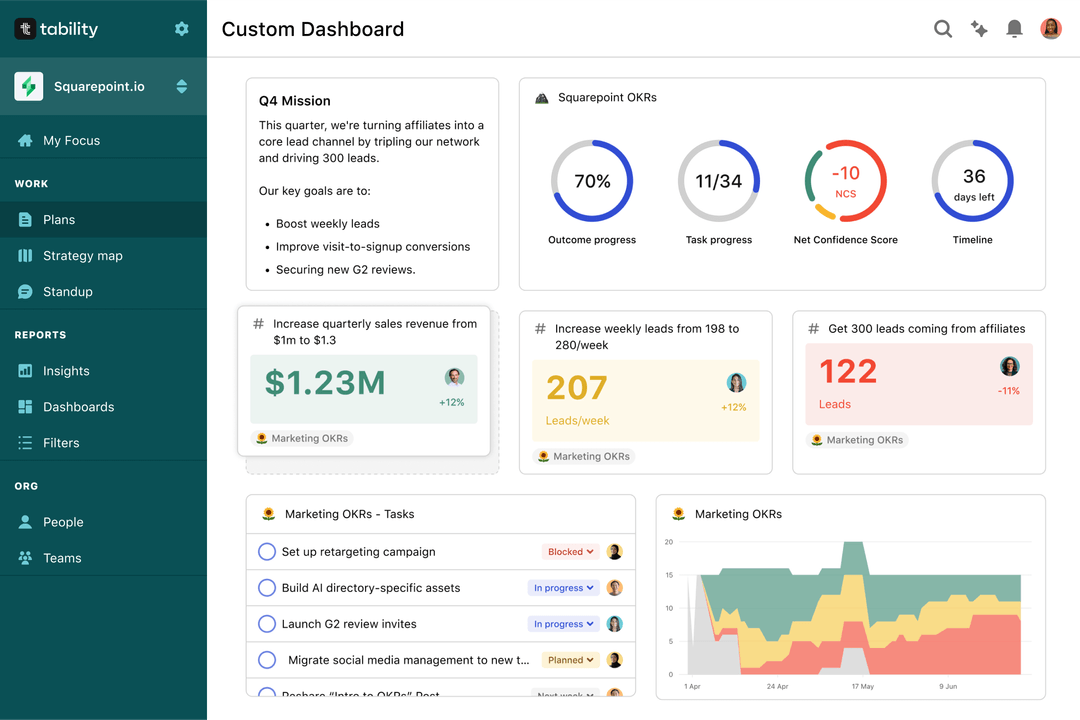Tability is a cheatcode for goal-driven teams. Set perfect OKRs with AI, stay focused on the work that matters.
What are Healthy Diet OKRs?
The Objective and Key Results (OKR) framework is a simple goal-setting methodology that was introduced at Intel by Andy Grove in the 70s. It became popular after John Doerr introduced it to Google in the 90s, and it's now used by teams of all sizes to set and track ambitious goals at scale.
OKRs are quickly gaining popularity as a goal-setting framework. But, it's not always easy to know how to write your goals, especially if it's your first time using OKRs.
To aid you in setting your goals, we have compiled a collection of OKR examples customized for Healthy Diet. Take a look at the templates below for inspiration and guidance.
If you want to learn more about the framework, you can read our OKR guide online.
The best tools for writing perfect Healthy Diet OKRs
Here are 2 tools that can help you draft your OKRs in no time.
Tability AI: to generate OKRs based on a prompt
Tability AI allows you to describe your goals in a prompt, and generate a fully editable OKR template in seconds.
- 1. Create a Tability account
- 2. Click on the Generate goals using AI
- 3. Describe your goals in a prompt
- 4. Get your fully editable OKR template
- 5. Publish to start tracking progress and get automated OKR dashboards
Watch the video below to see it in action 👇
Tability Feedback: to improve existing OKRs
You can use Tability's AI feedback to improve your OKRs if you already have existing goals.
- 1. Create your Tability account
- 2. Add your existing OKRs (you can import them from a spreadsheet)
- 3. Click on Generate analysis
- 4. Review the suggestions and decide to accept or dismiss them
- 5. Publish to start tracking progress and get automated OKR dashboards

Tability will scan your OKRs and offer different suggestions to improve them. This can range from a small rewrite of a statement to make it clearer to a complete rewrite of the entire OKR.
Healthy Diet OKRs examples
You'll find below a list of Objectives and Key Results templates for Healthy Diet. We also included strategic projects for each template to make it easier to understand the difference between key results and projects.
Hope you'll find this helpful!
OKRs to achieve a healthier body by losing weight
ObjectiveAchieve a healthier body by losing weight
KRIncrease daily step count to 10,000 steps for improved physical activity
Use stairs instead of elevators whenever possible
Commit to a daily after-dinner stroll
Start taking daily morning walks or jogs before work
KRReduce junk food intake by 50% to maintain a healthy diet
Increase water intake to suppress unhealthy cravings
Cut down portion sizes of junk food by half
Replace snack items with healthy alternatives like fruits and nuts
KRLose 15 pounds through regular exercise and balanced diet
Limit caloric intake and prioritize whole, nutritious foods
Initiate daily 30-minute cardio or strength training workouts
Drink at least 8 glasses of water daily
OKRs to lose 15 pounds while maintaining health and vitality
ObjectiveLose 15 pounds while maintaining health and vitality
KRCut back on sugar and processed foods, incorporating more fruits and vegetables
Reduce portion sizes of sugary and processed foods
Substitute processed snacks with healthy alternatives
Increase daily intake of fruits and vegetables
KRDecrease daily calorie intake by 500 for a weekly 3500-calorie deficit
Increase physical activities to burn calories
Incorporate low-calorie foods in each meal
Remove high-calorie snacks and dessert from daily diet
KREngage in 30-minute physical exercises 5 days a week
Prepare a 30-minute workout routine that suits your level
Set a daily alarm to remind you of your 30-minute exercise time
Track your weekly exercise progress and adjust if needed
Healthy Diet OKR best practices
Generally speaking, your objectives should be ambitious yet achievable, and your key results should be measurable and time-bound (using the SMART framework can be helpful). It is also recommended to list strategic initiatives under your key results, as it'll help you avoid the common mistake of listing projects in your KRs.
Here are a couple of best practices extracted from our OKR implementation guide 👇
Tip #1: Limit the number of key results
The #1 role of OKRs is to help you and your team focus on what really matters. Business-as-usual activities will still be happening, but you do not need to track your entire roadmap in the OKRs.
We recommend having 3-4 objectives, and 3-4 key results per objective. A platform like Tability can run audits on your data to help you identify the plans that have too many goals.
Tip #2: Commit to weekly OKR check-ins
Don't fall into the set-and-forget trap. It is important to adopt a weekly check-in process to get the full value of your OKRs and make your strategy agile – otherwise this is nothing more than a reporting exercise.
Being able to see trends for your key results will also keep yourself honest.
Tip #3: No more than 2 yellow statuses in a row
Yes, this is another tip for goal-tracking instead of goal-setting (but you'll get plenty of OKR examples above). But, once you have your goals defined, it will be your ability to keep the right sense of urgency that will make the difference.
As a rule of thumb, it's best to avoid having more than 2 yellow/at risk statuses in a row.
Make a call on the 3rd update. You should be either back on track, or off track. This sounds harsh but it's the best way to signal risks early enough to fix things.
Save hours with automated Healthy Diet OKR dashboards

The rules of OKRs are simple. Quarterly OKRs should be tracked weekly, and yearly OKRs should be tracked monthly. Reviewing progress periodically has several advantages:
- It brings the goals back to the top of the mind
- It will highlight poorly set OKRs
- It will surface execution risks
- It improves transparency and accountability
We recommend using a spreadsheet for your first OKRs cycle. You'll need to get familiar with the scoring and tracking first. Then, you can scale your OKRs process by using Tability to save time with automated OKR dashboards, data connectors, and actionable insights.
How to get Tability dashboards:
- 1. Create a Tability account
- 2. Use the importers to add your OKRs (works with any spreadsheet or doc)
- 3. Publish your OKR plan
That's it! Tability will instantly get access to 10+ dashboards to monitor progress, visualise trends, and identify risks early.
More Healthy Diet OKR templates
We have more templates to help you draft your team goals and OKRs.
OKRs to enhance the efficiency and stability of the IT infrastructure
OKRs to boost stealth bed and chair pad sales by 20%
OKRs to enhance efficiency of the media asset management system
OKRs to minimize overdue 90-day balances
OKRs to master SQL and relational modeling to enhance data analysis skills
OKRs to engage with customers on their most requested features